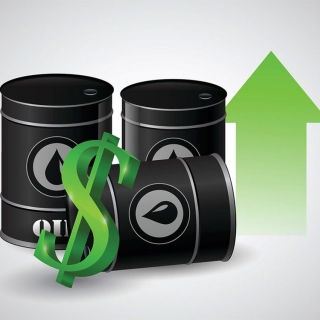


Oil prices surged on Monday to their highest since January as the United States' move over the weekend to join Israel in striking Iran's nuclear facilities stoked supply concerns.
Brent crude futures rose $1.52, or 1.97%, to $78.53 a barrel by 0503 GMT. U.S. West Texas Intermediate crude futures rose $1.51, or 2.04%, to $75.35. Both contracts jumped more than 3% earlier in the session to $81.40 and $78.40, respectively, touching five-month highs before giving up some of the gains.
The price surge came after U.S. President Donald Trump said he had "destroyed" Iran's main nuclear site in an attack over the weekend, joining Israeli strikes in an escalation of the Middle East conflict as Tehran vows to defend itself.
Iran is OPEC's third-largest crude producer. Market participants expect further price gains amid growing concerns that Iranian retaliation could include closing the Strait of Hormuz, through which about a fifth of global crude supplies pass.
"The current geopolitical escalation is providing a fundamental catalyst for (Brent) prices to move higher and potentially move towards $100, with $120 a barrel looking increasingly plausible," said Sugandha Sachdeva, founder of New Delhi-based research firm SS WealthStreet.
Iran's Press TV reported that Iran's parliament had approved a measure to close the strait. Iran has previously threatened to close the strait but never followed through.
Iran and Israel traded air and missile attacks on Monday, as global tensions escalated over Tehran's expected response to a U.S. attack on its nuclear facilities.
"The risk of damage to oil infrastructure ... has multiplied," said June Goh, senior analyst at Sparta Commodities.
Despite alternative pipeline routes out of the region, there will still be volumes of crude that cannot be fully exported if the Strait of Hormuz is inaccessible. Shippers will increasingly shy away from the region, she added.
Goldman Sachs said in a report Sunday that Brent could peak at $110 a barrel if oil flows through the vital waterway were cut in half for a month, and remain down 10% for the next 11 months. The bank still assumed no significant disruption to oil and natural gas supplies, adding to the global incentive to try and prevent a sustained and very large disruption.
Brent has risen 13% since the conflict began on June 13, while WTI has gained about 10%. Given that the Strait of Hormuz is vital to Iran's own oil exports, a vital source of its national income, a continued closure would inflict severe economic damage on Iran itself, making it a double-edged sword, Sachdeva added.
Meanwhile, Japan on Monday called for a de-escalation of the conflict in Iran, while South Korea's vice industry minister voiced concern over the potential impact of the attack on the country's trade. (alg)
Source: Reuters
Oil prices fell over 1% on Tuesday as OPEC+'s decision to pause output hikes in the first quarter next year along with weak manufacturing data and a stronger dollar weighed on the market. Brent crude...
Oil dipped after a four-day run of gains as the market weighed OPEC+'s decision to pause output hikes early next year and contrasting views on supply. West Texas Intermediate traded near $...
Oil prices were little changed despite news that OPEC+ plans to end its supply increases, with the market weighed down by concerns about oversupply and weak factory data in Asia. Brent crude futures ...
Oil prices rose in early Asian trading after OPEC and its allies (OPEC+) agreed to increase production by 137,000 barrels per day in December. Despite the increase, the group stated that it would not ...
Oil prices headed for a third straight monthly decline, falling on Friday (October 31st) due to a stronger US dollar, weak Chinese data, and rising supply from major global producers. Brent crude fut...
The USD/JPY pair declines on Tuesday to around 153.50 at the time of writing, down 0.40% on the day, as the Japanese Yen (JPY) attracts fresh safe-haven flows amid renewed global risk aversion. Fears of potential intervention from Japan's Ministry...
European stocks slipped mostly lower Tuesday, with investors locking in some profits on the back of an uncertain economic outlook and with more corporate earnings to digest. The DAX index in Germany closed 0.8% lower, the CAC 40 in France slipped...
Gold slipped slightly Tuesday, pressured by a stronger U.S. dollar and lingering uncertainty over the Federal Reserve's next policy move. Spot gold fell 0.8% to $3,970.08 per ounce and U.S. Gold Futures declined 0.8% to $3,980.31 per ounce. The...
 Asian stocks opened lower on Tuesday, reversing Wall Street's rally fueled by Amazon's massive $38 billion deal with OpenAI. Stock markets in South...
Asian stocks opened lower on Tuesday, reversing Wall Street's rally fueled by Amazon's massive $38 billion deal with OpenAI. Stock markets in South...

 European stocks opened slightly higher in November, with the STOXX 50 and STOXX 600 gaining 0.2%, after closing near record highs in October....
European stocks opened slightly higher in November, with the STOXX 50 and STOXX 600 gaining 0.2%, after closing near record highs in October....
 The economic activity in the United States' (US) manufacturing sector continued to contract in October, with the Institute for Supply Management's...
The economic activity in the United States' (US) manufacturing sector continued to contract in October, with the Institute for Supply Management's...